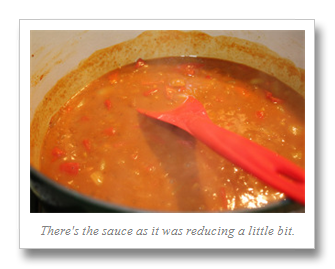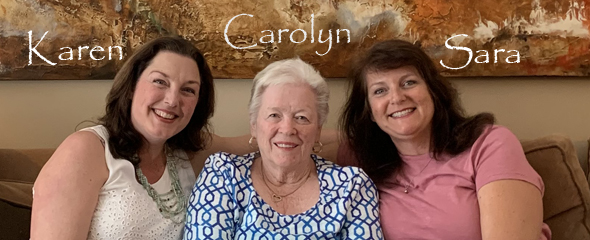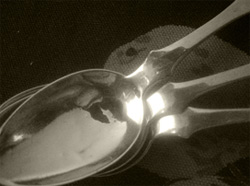Over the years of my cooking history, I’ve made Country Captain from a recipe in one of my homespun cookbooks. And it just never tasted all that great. All I remember was the volume of tomatoes. And in a gloppy watery tomato-ey sauce. It just didn’t hit any taste buttons for me. So after trying two similar recipes (this would have been in the 60’s or 70’s, I guess) I never looked at any Country Captain recipe again. Until now!
Why now? Well, I bought a new cookbook – like I need more cookbooks – but never mind that, since I have no reason when it comes to cookbooks – from Cook’s Illustrated, called Cover and Bake. (Apparently this book is so new it isn’t up on their website yet.) I don’t know about you, but sometimes when I entertain, it surely helps to be able to do some things ahead. Or do more one-dish meals. I thought this cookbook would help in that endeavor. Once I got this cookbook I started at the beginning and scanned through every recipe in the book. I put little pink stickies at the top of every page I wanted to try (I do that so I can easily find them when I’m searching for something new to try).
Fond? What’s that?
It’s the brown stuff that sticks to your skillet after browning anything – that’s where the best flavor comes from. Just make sure it’s not burned, but suitably golden brown!
As with most things related to Cook’s Illustrated, they wrote up a nice article before sharing each recipe. With an in-depth explanation of how they came about preparing each dish the way they did. I always like reading that part. It’s kind of like an ah-ha moment when you read that, for instance in this recipe, they decided to leave the chicken skin on while browning them, but then the skin was removed. They thought nobody really eats skin anymore, especially after being simmered in liquid, but the dish was decidedly bland without that step. So, browning with skin allowed the chicken to have more flavor.
The history of the dish is interesting – nobody is certain, but they think it was from one of two sources: (1) a British sea captain bringing spices from India to the New World (the early 1800’s) introduced the residents of Savannah, Georgia, to curry powder, paprika and cayenne pepper; or (2) a captain of Indian troops (called country troops) served the dish to British soldiers, also in the early 1800’s. In any case, it became a frequent dinner dish in Savannah, and apparently still is! Country Captain came into great favor when President Franklin D. Roosevelt served it at his “Little White House,” in Warm Springs, Georgia. Including General George Patton. It’s well known that FDR really liked this dish.
Some recipes call for bacon and orange juice, but Cook’s Illustrated decided they didn’t enhance the stew at all. They added both curry powder and cayenne, as well as bay leaf and thyme. And they also added sweet paprika and fresh mango to the stew. Some recipes call for mango chutney, but they decided that made the stew too strong and sweet. So fresh mango was tried and remained in the finished recipe. They also added raisins.
As with many curries, they’re usually served with a variety of condiments. In this case Cook’s Illustrated offered the stew to their testers and decided there are five that met their ultimate taste tests: toasted, sliced almonds, fresh banana, shredded sweetened coconut, Granny Smith apple tidbits, and scallions. I added fresh yogurt to the mix because the curry was w-a-r-m. And yogurt tempers spicy-heat very well.
Recipe Tip:
Be sure to use bone-in chicken thighs – with skin. Those bones and skin add lots of flavor to a stew. The skin is removed once the chicken is well browned.
Making a double batch took me longer to complete than I’d anticipated. We had 9 for dinner and it took a leap of faith that this dish would be appreciated by our guests – not everyone likes curry! You don’t want to crowd the pan with chicken as it will steam rather than brown, so it took me 4 batches to brown 16 thighs. At 5 minutes per side per sauté. Nothing about the recipe is hard – it helps to gather all the ingredients ahead of time and have everything all chopped and ready to add when needed. Nearly all the cooking is done in the oven, although I decided to use my large All-Clad stainless skillet for the browning – rather than the Dutch oven – then I deglazed it with water afterwards to get all that fond off the bottom.

Adding some Penzey’s chicken soup base (it’s a concentrate) to the water allowed me to make that the broth added to the stew. Eventually everything went into my big Le Crueset pot and into the oven. The chicken must be submerged in order to become tender and not dry.
When the dish was baked sufficiently, the sauce seemed a bit watery to me (no watery Country Captain allowed!) so I removed all the chicken pieces and reduced (boiled down) the remaining sauce (about 10 minutes) until it was nicely thickened to my liking, stirring frequently. Since it was going on top of rice, I wanted it to be more sauce-like than soup-like. That step, not in the original recipe, worked perfectly. The chicken pieces were put back into the sauce and cooked until it was almost falling apart.
This chicken was stupendous. A real winner, thanks to the folks at Cook’s Illustrated. There were multiple layers of flavors, and I liked every one of them. And, incidentally, I’d use all of those condiments again – they really added a lot to the finished dish. I happened to use medium-hot curry powder, and it had a bit of a kick to it. Everyone liked it, I’m glad to say, and some of our guests had no idea I was going to serve a spicy curry for dinner. Once the yogurt was mixed in (on top) and the condiments added to most bites, it tamed the heat quite well. Use your own discretion about the heat volume.
printer-friendly PDF
Country Captain Chicken
Recipe By: Cook’s Illustrated’s cookbook, “Cover and Bake”
Serving Size: 4
Notes: The condiments mentioned MAKE the dish – don’t eliminate them. The original recipe also called for sweetened shredded coconut too. If the sauce is not thick enough after baking, remove all the chicken pieces and reduce the sauce until it’s thick enough to your liking. Then add the chicken pieces back into the sauce. If you use a spicier curry powder you may not need the cayenne.
8 whole chicken thighs — bone-in and with skin (skin removed later)
Salt and pepper to taste
1 tablespoon vegetable oil
2 large onions — peeled, coarsely chopped
1 medium bell pepper — (I used red; recipe calls for green)
2 medium garlic cloves — peeled, mashed and minced
1 1/2 tablespoons sweet paprika
1 tablespoon curry powder — Madras style (or any kind)
1/4 teaspoon cayenne
3 tablespoons all-purpose flour
1 1/2 cups low-sodium chicken broth
14 1/2 ounces canned tomatoes — diced
1 whole bay leaf
1/2 teaspoon dried thyme
1/2 cup raisins
1 whole mango — peeled, pitted and cut into 1/4 inch dice
1/4 cup Italian parsley — chopped
CONDIMENTS:
1/2 cup sliced almonds — toasted
1 whole Granny Smith apple — peeled, diced very small
4 whole green onions — thinly sliced
1 whole banana — peeled, diced very small
1. Adjust oven rack to the lower-middle shelf and heat to 300.
2. Trim the chicken thighs of extra or hanging fat. Dry them with paper towels, then season with salt and pepper. Heat the oil in a large ovenproof Dutch oven over medium-high heat until the oil shimmers. Carefully add the chicken thighs, just a few at a time – don’t crowd the pan or they won’t brown properly. Saute/brown them skin side down for about 5 minutes without moving them at all. Turn them over and brown the other side. Remove to a large plate and set aside. You may need to do more than one batch of the browning. Once the chicken has cooled enough to handle, remove all the chicken skin and discard.
3. Discard all but about a tablespoon of oil (fat) in the bottom of the pan. Add the chopped onions and bell peppers. Cook for about 5 minutes, then add the paprika, cayenne, curry powder and garlic and continue cooking briefly, about one minute. Add the flour and stir to combine it carefully with the vegetables, without burning, for about 2 minutes. Add the chicken broth, bring to a boil, then reduce heat and allow to simmer for about 10 minutes. Add the canned tomatoes, bay leaf, thyme, raisins and mango.
4. Bring this mixture to a boil, then add the chicken pieces, submerging them all below the surface. Bring to a simmer, cover and place in the preheated oven for about 1 1/4 hours, or until the chicken is fork tender, but is still clinging to the bone. (Don’t overcook.)
5. Remove from the oven, stir in the parsley, discard the bay leaf and adjust the seasonings as needed. Serve immediately with garnishes of your choice. It’s traditional to serve it over rice.
Per Serving (assuming 2 thighs per person – at our dinner most people ate just one because they were medium-to-large size): 767 Calories; 44g Fat (48.9% calories from fat); 45g Protein; 58g Carbohydrate; 9g Dietary Fiber; 158mg Cholesterol; 325mg Sodium.
A year ago: Szechuan Green Beans with Turkey
Two years ago: Kurobuta Ham with David Rosengarten’s Mustard Sauce







~Misty
said on March 30th, 2015:
This was really good my entire family enjoyed, adults, teenagers, and preschoolers! We raise our own chickens in the summer time and then freeze them whole, so I used a cut up whole chicken and all of the meat was tender and yummy. I served with all the condiments including coconut and served it over basmati rice. Thanks for posting this great recipe, looking forwarding to trying some of your other recipes!
Thanks, Misty! So glad you enjoyed it. I’m just returned from a trip, and one thing I’m craving is curried chicken over basmati, so I think I’ll be making a BIG batch and freezing it in small portions. . . carolyn t
alice sitbythefire
said on December 23rd, 2016:
BLESS YOU A THOUSANDFOLD FOR PUTTING IN THE ORIGINAL “COOKS” RECIPE – so I could copy and print it without having to re-write it from my Cook’s Illustrated.. I used it for the 1st time (I’m 86 years old) a week ago and we were all flabbergasted by how easy it is to make and delicious to eat! Bless you, too, for recommending Penzey’s (no relation of mine, don’t own any of their stock – unless the chicken stock counts) whose soup bases I always find the most like natural flavors. I used, forgive me, *none* of the condiments and nobody missed ’em. The stew itself is so full of flavor we felt no need to gild the bird!
Am so glad you enjoyed that recipe. I’d a good one, for sure. Thanks for reading my blog! . . . carolyn t